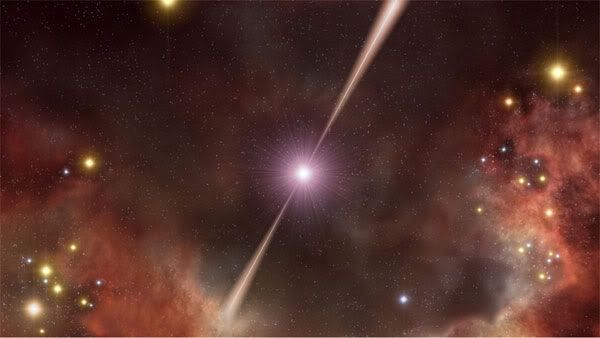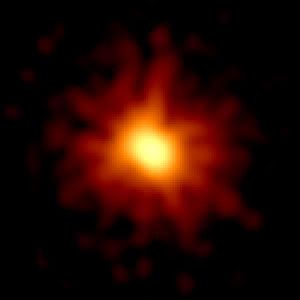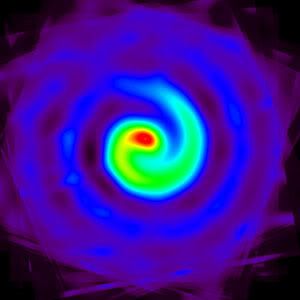Ok, so I have gamma ray bursts on the brain at the minute, which isn't unexpected after reading about them for a week. Besides, frankly, they're so damn fascinating! Seriously, the most dramatically powerful events in the known Universe, and we still don't know precisely what causes them. Just... fascinating. So to let some of this escape from my brain, here's 8 things about GRBs which may interest you...

It's one of these beams of intensely bright radiation that we see as a "Gamma Ray Burst".
If two neutron stars get trapped together by gravity, it's thought that they would slowly and inexorably fall together. As they rotate around each other, they would emit gravitational waves, losing energy and thus losing speed. With the loss of speed, they'd lose orbital distance. Eventually (probably over millions of years), they'd fall so close together that they'd crash into each other. The collision would be violent, but swift, emitting a brief but gargantuan belch of gamma rays before both stars collapsed into a silent black hole.
One day before my 24th birthday in 2004, a blast of gamma radiation saturated every single gamma ray satellite in orbit. It was so powerful it even disrupted Earth's ionosphere. The source? A type of rare, highly magnetised neutron star, known as a magnetar. The specific one, SGR 1806-20, is one of only five known in our entire galaxy.
Whether megaflares could be the source of some GRBs or not is disputed, but one thing's for certain. A megaflare like the one in 2004 would be easily observable in another galaxy.
 Gamma ray bursts don't just emit gamma rays. They also have an "afterglow" that covers the entire electromagnetic spectrum. X-rays and ultraviolet right the way down to infrared and radio waves.
Gamma ray bursts don't just emit gamma rays. They also have an "afterglow" that covers the entire electromagnetic spectrum. X-rays and ultraviolet right the way down to infrared and radio waves.
In March 2008, one burst (GRB 080319B) was so bright that you would have been able to see it with the naked eye for 30 seconds. Despite a redshift of 0.937. Let's put that into perspective -- because of the way redshifts work, a redshift of 1 can be considered to be about halfway across the observable Universe. Loosely 7.5 billion light years away. This GRB was half a Universe away and visible to the naked eye! Incredible.
Interestingly, seeing a GRB this old implies that massive stars were indeed forming and dying in the early Universe. It was probably stars like these that created the heavier elements that would eventually form cosmic dust, planets... and us.
Instead of detecting nuclear weapons though, project Vela detected GRB 670702! After several more were observed, the Los Alamos National Laboratory published the paper Observations of Gamma-Ray Bursts of Cosmic Origin -- the first ever publication on GRBs. Since then, GRB research has blossomed into a research field in it's own right.
When we talk about GRBs, we're talking about something violent enough that we can see them from the other side of the Universe. Think about it. That isn't something you'd want to happen in your backyard. It's a worthwhile concern though. A nearby gamma ray burst would severely damage Earth's biosphere. Those gamma rays, much tougher than the worst solar flare imaginable, would fry the upper atmosphere. Nitrogen and oxygen would be forcibly reacted into nitric oxide, and nitric oxide is sadly rather good at destroying ozone. It's been calculated that a nearby GRB hitting Earth for just 10 seconds could destroy up to half of Earth's ozone. It would take at least five years for the ozone layer to recover, during which time ultraviolet from the Sun would play havoc with life on land.
Worryingly, it's even been considered that the Ordovician-Silurian extinction events 450 million years ago could have been caused by just such a gamma ray burst.
 GRBs are mercifully rare. Some estimate that just one burst will occur in the Milky Way every hundred thousand years to every million years. Others believe that bursts can only happen in galaxies with much fewer heavy elements than the Milky Way ("Metal-poor" galaxies).
GRBs are mercifully rare. Some estimate that just one burst will occur in the Milky Way every hundred thousand years to every million years. Others believe that bursts can only happen in galaxies with much fewer heavy elements than the Milky Way ("Metal-poor" galaxies).
Some astronomers were concerned for a while about a star named WR 104 (shown in this image here), an ageing massive star (known as a Wolf-Rayet star). The trouble is, we don't know enough about gamma ray bursts to say if this star could produce one. If it could, the star's rotational axis is aligned within about 16° of Earth which would make this a rather dangerous place to be living. Reassuringly, most now believe that WR 104 it isn't the "loaded gun" we once thought it was, and is unlikely to produce a gamma ray burst.
But there's no way we can really know for certain...

1. There are "long bursts"...
Long bursts are widely believed to be a type of supernova event. In fact, some have been observed in association with a supernova (the first being GRB 980425). The process is suitably melodramatic. As soon as an extremely massive, fast rotating star burns enough fuel, it's core becomes so massive that it can't withstand it's own gravity. It collapses, in a similar way to a regular supernova, but it doesn't stop there. Because these stars are so massive, more and more stellar material is sucked into the core, collapsing it directly into a black hole. The star then proceeds to devour itself, releasing such vast amounts of energy that two beams of energy puncture the star at it's North and South poles. Think about that for a moment. Enough energy to puncture a star. A massive one at that!It's one of these beams of intensely bright radiation that we see as a "Gamma Ray Burst".
2. ...and there are "short bursts"
Short gamma ray bursts are believed to come from something altogether different. While there are competing theories and diagreement, many believe that short bursts come from two neutron stars colliding. While neutron stars are so tiny, you might not expect them to ever come close enough to collide, don't forget that an average neutron star will be twice as massive as the Sun and have gravity to match.If two neutron stars get trapped together by gravity, it's thought that they would slowly and inexorably fall together. As they rotate around each other, they would emit gravitational waves, losing energy and thus losing speed. With the loss of speed, they'd lose orbital distance. Eventually (probably over millions of years), they'd fall so close together that they'd crash into each other. The collision would be violent, but swift, emitting a brief but gargantuan belch of gamma rays before both stars collapsed into a silent black hole.
3. (Actually, there are other types too)
There's a third theory which is sometimes accepted as the cause of some gamma ray bursts. Megaflares.One day before my 24th birthday in 2004, a blast of gamma radiation saturated every single gamma ray satellite in orbit. It was so powerful it even disrupted Earth's ionosphere. The source? A type of rare, highly magnetised neutron star, known as a magnetar. The specific one, SGR 1806-20, is one of only five known in our entire galaxy.
Whether megaflares could be the source of some GRBs or not is disputed, but one thing's for certain. A megaflare like the one in 2004 would be easily observable in another galaxy.
4. You can see them from halfway across the Universe
 Gamma ray bursts don't just emit gamma rays. They also have an "afterglow" that covers the entire electromagnetic spectrum. X-rays and ultraviolet right the way down to infrared and radio waves.
Gamma ray bursts don't just emit gamma rays. They also have an "afterglow" that covers the entire electromagnetic spectrum. X-rays and ultraviolet right the way down to infrared and radio waves.In March 2008, one burst (GRB 080319B) was so bright that you would have been able to see it with the naked eye for 30 seconds. Despite a redshift of 0.937. Let's put that into perspective -- because of the way redshifts work, a redshift of 1 can be considered to be about halfway across the observable Universe. Loosely 7.5 billion light years away. This GRB was half a Universe away and visible to the naked eye! Incredible.
5. We've found one from shortly after the Universe was born!
The record holder for most distant object ever observed was a gamma ray burst. Just last month, GRB 090423 was picked up by the Swift satellite. It lasted about 10 seconds, and was measured to have a redshift of 8.2. Whatever caused it exploded roughly 13 billion years ago -- estimated at a mere 630 million years after the Big Bang. The Universe was just a baby back then. Even the galaxies were young that long ago.Interestingly, seeing a GRB this old implies that massive stars were indeed forming and dying in the early Universe. It was probably stars like these that created the heavier elements that would eventually form cosmic dust, planets... and us.
6. We've known about them since the Cold War
We've actually known about gamma ray bursts since 1967. In 1963, the Partial Test Ban Treaty was drawn up to prevent the deployment of nuclear weaponry in outer space and the upper atmosphere (as well as under water). In order to monitor this, the US military developed Project Vela.Instead of detecting nuclear weapons though, project Vela detected GRB 670702! After several more were observed, the Los Alamos National Laboratory published the paper Observations of Gamma-Ray Bursts of Cosmic Origin -- the first ever publication on GRBs. Since then, GRB research has blossomed into a research field in it's own right.
7. They're rather dangerous
Ok, that's an understatement. On the list of "Things which could cause the end of the world", GRBs are pretty high up there.When we talk about GRBs, we're talking about something violent enough that we can see them from the other side of the Universe. Think about it. That isn't something you'd want to happen in your backyard. It's a worthwhile concern though. A nearby gamma ray burst would severely damage Earth's biosphere. Those gamma rays, much tougher than the worst solar flare imaginable, would fry the upper atmosphere. Nitrogen and oxygen would be forcibly reacted into nitric oxide, and nitric oxide is sadly rather good at destroying ozone. It's been calculated that a nearby GRB hitting Earth for just 10 seconds could destroy up to half of Earth's ozone. It would take at least five years for the ozone layer to recover, during which time ultraviolet from the Sun would play havoc with life on land.
Worryingly, it's even been considered that the Ordovician-Silurian extinction events 450 million years ago could have been caused by just such a gamma ray burst.
8. We're safe. For now. So we think.
 GRBs are mercifully rare. Some estimate that just one burst will occur in the Milky Way every hundred thousand years to every million years. Others believe that bursts can only happen in galaxies with much fewer heavy elements than the Milky Way ("Metal-poor" galaxies).
GRBs are mercifully rare. Some estimate that just one burst will occur in the Milky Way every hundred thousand years to every million years. Others believe that bursts can only happen in galaxies with much fewer heavy elements than the Milky Way ("Metal-poor" galaxies).Some astronomers were concerned for a while about a star named WR 104 (shown in this image here), an ageing massive star (known as a Wolf-Rayet star). The trouble is, we don't know enough about gamma ray bursts to say if this star could produce one. If it could, the star's rotational axis is aligned within about 16° of Earth which would make this a rather dangerous place to be living. Reassuringly, most now believe that WR 104 it isn't the "loaded gun" we once thought it was, and is unlikely to produce a gamma ray burst.
But there's no way we can really know for certain...
No comments:
Post a Comment